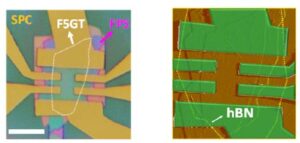
Electrical gate control in vdW heterostructures towards future spintronics
A FLEET RMIT-led international collaboration in 2022 observed, for the first time, electric gate-controlled exchange-bias effect in a van der Waals (vdW) hetero-structure, offering a promising platform for future energy-efficient, beyond-CMOS spintronics.
This new form of gate control would provide scalable, energy-efficient spin-orbit logic, which is very promising for beyond-CMOS devices in future low-energy electronic technologies.
It is the first successful significant manipulation of the exchange-bias effect (which is caused by interlayer magnetic coupling), which has been a significant goal in spintronics.
Electrical gate-manipulated exchange-bias effects in such magnetic hetero-structures enable scalable, energy-efficient spin-orbit logic, with the ‘blocking’ temperature of the exchange-bias effect effectively tuned via an electric gate.

This would allow the exchange-bias field to be turned ‘ON’ and ‘OFF’ in future spintronic transistors.
The FLEET-led collaboration of researchers at RMIT University and South China University of Technology confirmed for the first time the electric control of exchange-bias effect in a vdW heterostructure comprising antiferromagnetic (AFM) and ferromagnetic (FM) layers.
Such vdW magnetic hetero-structures provide an ideal platform for exploring interfacial magnetic-coupling mechanisms, boosting the development of vdW magnetic and spintronic devices.
The exchange-bias effect originates from the AFMFM interface coupling-induced unidirectional anisotropy. FLEET Research Fellow Dr Sultan Albarakati (RMIT)
“We decided it was time to utilise our experience in vdW hetero-structure-based nanodevices and gate control towards control magnetic properties in FM/ AFM bilayers,” says the study’s first author, FLEET Research Fellow Dr Sultan Albarakati (RMIT).
The team was also familiar with proton intercalation, which is an effective tool for modulating materials’ charge density.
The team’s expertise with magnetic materials informed materials chosen for the successful structure: a three-layer nanodevice featuring a ferromagnetic layer, antiferromagnetic layer and solid proton conductor.
The team then observed the shift of exchange-bias fields under different gate voltages.

“The blocking temperature of the exchange-bias effect can be effectively tuned via an electric gate. And more interestingly, the EB field can be switched ‘ON’ and ‘OFF’ repeatably under various gate voltages,” says co-author Dr Guolin Zheng (RMIT).
“Electric Control of Exchange Bias Effect in FePS3−Fe5GeTe2 van der Waals Heterostructures” was published in Nano Letters in August 2022. (DOI: 10.1021/acs.nanolett.2c01370)
